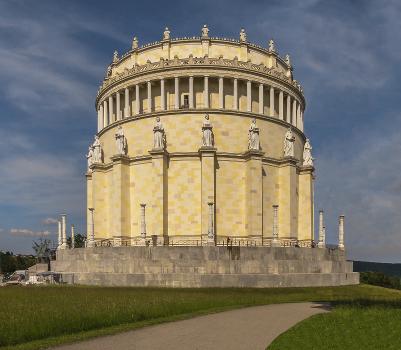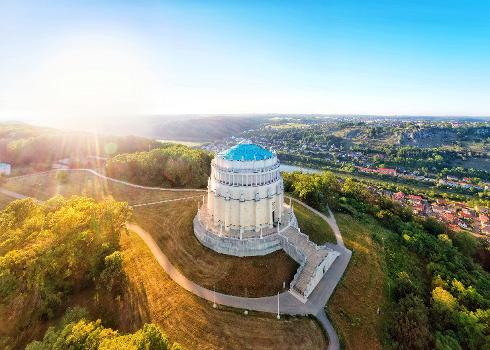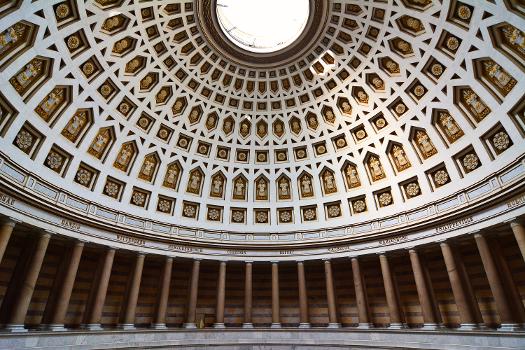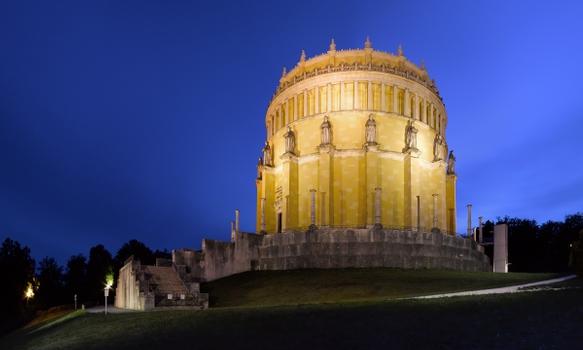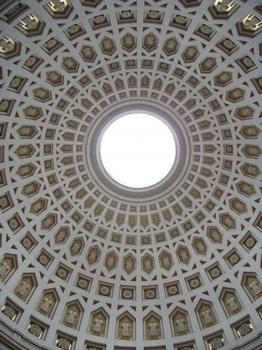General Information
Project Type
| Structure: |
Dome |
|---|---|
| Function / usage: |
Monument |
| Material: |
Iron structure |
| Architectural style: |
Neoclassical |
| Plan view: |
Structurae Plus/Pro - Subscribe Now! |
Awards and Distinctions
Location
| Location: |
Kelheim, Kelheim (Kreis), Bavaria, Germany |
|---|---|
| Address: | Befreiungshallestraße 3 |
| Coordinates: | 48° 55' 6.88" N 11° 51' 37.34" E |
Technical Information
Dimensions
| diameter | 29 m | |
| height | 45 m |
Building History of the Hall of Liberation
The Liberation Hall is a monument on the Michelsberg above the city of Kelheim and stands upstream from Regensburg at the confluence of the Altmühl or Main-Danube Canal with the Danube. The liberation hall was built in memory of the battles won against Napoleon during the wars of liberation in the years from 1813 to 1815. The construction was commissioned by King Ludwig I of Bavaria.
The original design was by Friedrich von Gärtner based on ancient and Christian central building ideas. Construction began in 1842 with the laying of the foundation stone on October 19, but had to be interrupted for a short time in 1847 with Gärtner's death. King Ludwig I then commissioned Leo von Klenze to continue the work. Klenze submitted his first plans just three months later, which were based on Gärtner's basic concept but added neoclassical elements. Construction work could be resumed in the spring of 1848. Otto von Langenmantel, a student of Gärtner, was master builder for the hall from 1850 to 1856. The ceremonial opening of the hall took place on October 18, 1863, the 50th anniversary of the Battle of Leipzig.
Excerpt from Wikipedia
The Befreiungshalle ("Hall of Liberation", German: [bəˈfʀaɪ̯ʊŋsˌhalə]) is a neoclassical monument on the Michelsberg hill above the town of Kelheim in Bavaria, Germany. It stands upstream of Regensburg on the river Danube at the confluence of the Danube and the Altmühl, i.e. the Rhine–Main–Danube Canal. It is just downstream of the Danube Gorge, towering above its lower end. It was commissioned by King Ludwig I of Bavaria to commemorate the victory over Napoleon in the Befreiungskriege of 1813–1815.
History
King Ludwig I of Bavaria ordered the Befreiungshalle to be built in order to commemorate the victories against Napoleon during the Wars of Liberation that lasted from 1813 to 1815.
The construction was started in 1842 by Friedrich von Gärtner in a mixture of Neoclassical and Christian styles. It occurred on Michelsberg, in a place previously occupied by a part of the ruins of a pre-historic fortification or town, thought by some to have been Alcimoennis. At the behest of the King, Leo von Klenze later altered the plans and completed the building in 1863. The ceremonial opening took place on 18 October 1863 – the 50th anniversary of the Battle of Nations (Völkerschlacht) near Leipzig.
The following dictum by King Ludwig I, embedded into the marble floor, commemorates the occasion of the construction of the Befreiungshalle:
MOECHTEN DIE TEUTSCHEN NIE VERGESSEN WAS DEN BEFREIUNGSKAMPF NOTHWENDIG MACHTE UND WODURCH SIE GESIEGT. (May the Germans never forget what made necessary the Struggle for Freedom and by what means they won.)
This inscription of dedication is to be found above the ornamented door frame of the entrance portal:
DEN TEUTSCHEN BEFREIUNGSKAEMPFERN LUDWIG I KOENIG VON BAYERN (To the German Liberation Fighters Ludwig I King of Bavaria)
For the celebration of the first stone laying on 19 October Ludwig I had a poem written dedicated to the soldiers who had fought in the Napoleonic Wars. Joseph Hartmann Stutz had set it to music:
| German | English |
|---|---|
|
1. Heil Euch, wack’re Männer, muth’ge Krieger, Die errungen Ihr den Heldenkranz, Heil Euch, treue Teutsche, tapf’re Sieger! Ewig währet Eurer Thaten Glanz. |
1. Hail to you, valiant men, brave warriors Who have won a hero's wreath, Hail to you, faithful Germans, courageous victors! The brightness of your deeds will last forever. |
|
2. Dumpf und finster hatt es uns umgeben, Und kein Teutschland gab es damals mehr; Ihr doch schwangt auf’s Neue es zum Leben, Siegreich ragt es wieder hoch und hehr! |
2. We were surrounded by dull and dark forces, And Germany did no longer exist; But you reanimated her, And now she stands again victoriously and sublime! |
|
3. Dass die Zwietracht schmählich uns gekettet, Dies vergessen werde nie und nie, Dass die Eintracht uns allein gerettet, Die der Heimath Ruhm und Sieg verlieh. |
3. We will never forget That discord ignominiously chained us And that unity alone saved us, Unity which granted glory and victory to our country. |
|
4. Durch der Zeiten weite Ferne schlinge Immer sich der Eintracht heilig Band, In des Teutschen Seele sie durchdringe, Unbesiegt bleibt dann das Vaterland. |
4. May forever wind The holy band of concord, May it enter the German's soul, Then the fatherland will remain unvanquished. |
Text imported from Wikipedia article "Befreiungshalle" and modified on 26 January 2022 according to the CC-BY-SA 3.0 license.
Participants
- Otto von Langenmantel (master builder)
- Friedrich Wilhelm von Gärtner (architect)
- Leo von Klenze (architect)
Relevant Web Sites
Relevant Publications
- (2013): Modernes Eisentragwerk über klassizistischem Rundbau. In: Stahlbau, v. 82, n. 9 (September 2013), pp. 700-703.
- About this
data sheet - Structure-ID
20065902 - Published on:
24/01/2014 - Last updated on:
27/01/2022

